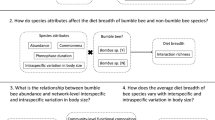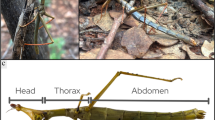Abstract
Generalist herbivores forage on a variety of plant species, allowing them to gain nutrients while limiting ingestion of harmful toxins. As the capacity to mix diets appears important for maximizing intake, the spatial scale in heterogeneity of food resources should influence the foraging behavior of herbivores. Our aim was to identify how the feeding strategy of a generalist mammalian herbivore, the common brushtail possum, responds to foods within a spatially defined environment. We evaluated foraging responses against increasing spatial separation between pairs of artificial diets that differed in flavor and toxin profile, to determine how distance and diet affect intake and behavior. Foraging responses were influenced by the type of diet or the degree of spatial separation between foods but not by their interaction. Diet influenced intake, time spent feeding, and feeding rate, but had no effect on nightly foraging interval, number of feeding bouts, or bout length. The number of switches between paired food resources and foraging efficiency (intake per unit distance, which accounts for the energetic costs of travelling), were influenced only by distance. Titrating foraging against a range of distances demonstrated how quickly foraging efficiency can decline in response to the spatial separation of food resources, highlighting the importance of spatial heterogeneity of plants within the home range of an herbivore.







Similar content being viewed by others
References
Behmer, S. T., Simpson, S. J., and Raubenheimer, D. 2002. Herbivore foraging in chemically heterogeneous environments: Nutrients and secondary metabolites. Ecology 83:2489–2501.
Bernays, E. A., Angel, J. E., and Augner, M. 1997. Foraging by a generalist grasshopper: The distance between food resources influences diet mixing and growth rate (Orthoptera: Acrididae). J. Insect Behav. 10:829–840.
Catanese, F., Distel, R. A., Provenza, F. D., and Villalba, J. J. 2012. Early experience with diverse foods increases intake of nonfamiliar flavors and feeds in sheep. J. Anim. Sci. 90:2763–2773.
Dearing, M. D. and Cork, S. 1999. Role of detoxification of plant secondary compounds on diet breadth in a mammalian herbivore, Trichosurus vulpecula. J. Chem. Ecol. 25:1205–1219.
Early, D. M. and Provenza, F. D. 1998. Food flavor and nutritional characteristics alter dynamics of food preference in lambs. J. Anim. Sci. 76:728–734.
Fitzgerald, A. E. 1984. Diet of the possum (Trichosurus vulpecula) in three Tasmanian forest types and its relevance to the diet of possums found in New Zealand forests, pp. 137–143, in A. P. Smith and I. D. HUME (eds.), Possums and gliders. Australian Mammal Society, Sydney.
Foley, W. J. and McArthur, C. 1994. The effects and costs of allelochemicals for mammalian herbivores: An ecological prospective, pp. 370–391, in D. J. Chivers and P. Langer (eds.), The digestive system in mammals: Food, form and function. Cambridge University Press, Cambridge.
Freeland, W. J. 1991. Plant secondary metabolites: Biochemical coevolution with herbivores, pp. 61–81, in R. T. Palo and C. T. Robbins (eds.), Plant defenses against mammalian herbivory. CRC Press, Boca Rotan.
Freeland, W. J. and Janzen, D. H. 1974. Strategies in herbivory by mammals: The role of plant secondary compounds. Am. Nat. 108:269–289.
Freeland, W. J. and Winter, J. W. 1975. Evolutionary consequences of eating: Trichosurus vulpecula (Marsupialia) and the genus EucalyptusJ. Chem. Ecol. 1:439–455.
Ginane, C., Baumont, R., Lassalas, J., and Petit, M. 2002. Feeding behaviour and intake of heifers fed on hays of various quality, offered alone or in a choice situation. Anim. Res. 51:177–188.
Hume, I. D. 1999. Marsupial nutrition. Cambridge University Press, New York.
Illius, A. W. and Jessop, N. S. 1995. Modeling metabolic costs of allelochemical ingestion by foraging herbivores. J. Chem. Ecol. 21:693–719.
Kare, M. R., Beauchamp, G. K., and Jacobs, W. W. 1977. Progress in animal flavor research. Abstr. Pap. Am. Chem. Soc. 174:7.
Lawler, I. R., Foley, W. J., and Eschler, B. M. 2000. Foliar concentration of a single toxin creates habitat patchiness for a marsupial folivore. Ecology 81:1327–1338.
Lawler, I. R., Foley, W. J., Eschler, B. M., Pass, D. M., and Handasyde, K. 1998. Intraspecific variation in Eucalyptus secondary metabolites determines food intake by folivorous marsupials. Oecologia 116:160–169.
Lawler, I. R., Stapley, J., Foley, W. J., and Eschler, B. M. 1999. Ecological example of conditioned flavor aversion in plant-herbivore interactions: Effect of terpenes of Eucalyptus leaves on feeding by common ringtail and brushtail possums. J. Chem. Ecol. 25:401–415.
le Mar, K., McArthur, C., and Statham, M. 2003. Home ranges of sympatric red-necked wallabies, red-bellied pademelons and common brushtail possums in a temperate eucalypt forestry environment. Aust. Mammal. 25:183–191.
MacLennan, D. G. 1984. The feeding behaviour and activity patterns of the brushtail possum, Trichosurus vulpecula, in an open eucalypt woodland in southeast Queensland, pp. 155–161, in A. P. SMITH and I. D. HUME (eds.), Possums and gliders. Australian Mammal Society, Sydney.
Marsh, K. J., Wallis, I. R., and Foley, W. J. 2005. Detoxification rates constrain feeding in common brushtail possums (Trichosurus vulpecula). Ecology 86:2946–2954.
Marsh, K. J., Wallis, I. R., and Foley, W. J. 2007. Behavioural contributions to the regulated intake of plant secondary metabolites in koalas. Oecologia 154:283–290.
Marsh, K. J., Wallis, I. R., McLean, S., Sorensen, J. S., and Foley, W. J. 2006. Conflicting demands on detoxification pathways influence how common brushtail possums choose their diets. Ecology 87:2103–2112.
McArthur, C., Hagerman, A. E., and Robbins, C. T. 1991. Physiological strategies of mammalian herbivores against plant defenses, pp. 103–114, in R. T. Palo and C. T. Robbins (eds.), Plant defenses against mammalian herbivory. CRC Press, Boca Rotan.
Miller, A. M., McArthur, C., and Smethurst, P. J. 2007. Effects of within-patch characteristics on the vulnerability of a plant to herbivory. Oikos 116:41–52.
Miller, A. M., McArthur, C., and Smethurst, P. J. 2009. Spatial scale and opportunities for choice influence browsing and associational refuges of focal plants. J. Anim. Ecol. 78:1134–1142.
Moore, B. D. and Foley, W. J. 2005. Tree use by koalas in a chemically complex landscape. Nature 435:488–490.
Morgan, D. R., Innes, J., Frampton, C. M., and Woolhouse, A. D. 1995. Responses of captive and wild possums to lures used in poison baiting. N. Z. J. Zool. 22:123–129.
Nersesian, C. L., Banks, P. B., Simpson, S. J., and McArthur, C. 2012. Mixing nutrients mitigates the intake constraints of a plant toxin in a generalist herbivore. Behav. Ecol. 23:879–888.
O’Reilly-Wapstra, J. M., McArthur, C., and Potts, B. M. 2002. Genetic variation in resistance of Eucalyptus globulus to marsupial browsers. Oecologia 130:289–296.
O’Reilly-Wapstra, J. M., McArthur, C., and Potts, B. M. 2004. Linking plant genotype, plant defensive chemistry and mammal browsing in a Eucalyptus species. Funct. Ecol. 18:677–684.
O’Reilly-Wapstra, J. M., Potts, B. M., McArthur, C., and Davies, N. W. 2005. Effects of nutrient variability on the genetic-based resistance of Eucalyptus globulus to a mammalian herbivore and on plant defensive chemistry. Oecologia 142:597–605.
Pass, G. J. and Foley, W. J. 2000. Plant secondary metabolites as mammalian feeding deterrents: separating the effects of the taste of salicin from its post-ingestive consequences in the common brushtail possum (Trichosurus vulpecula). J. Comp. Physiol. B Biochem. Syst. Environ. Physiol. 170:185–192.
Provenza, F. D. 1995. Postingestive feedback as an elementary determinant of food preference and intake in ruminants. J. Range Manage. 48:2–17.
Ratkowsky, D. A., Evans, M. A., and Alldredge, J. R. 1993. Cross-over experiments: Design, analysis and application. Marcel Dekker, New York.
Rolls, B. J., Rowe, E. A., Rolls, E. T., Kingston, B., Megson, A., and Gunary, R. 1981. Variety in a meal enhances food-intake in man. Physiol. Behav. 26:215–221.
Shipley, L. A., Forbey, J. S., and Moore, B. D. 2009. Revisiting the dietary niche: When is a mammalian herbivore a specialist ? Integr. Comp. Biol. 49:274–290.
Sorensen, J. S., McLister, J. D., and Dearing, M. D. 2005. Plant secondary metabolites compromise the energy budgets of specialist and generalist mammalian herbivores. Ecology 86:125–139.
Treit, D., Spetch, M. L., and Deutsch, J. A. 1983. Variety in the flavor of food enhances eating in the rat - a controlled demonstration. Physiol. Behav. 30:207–211.
Villalba, J. J. and Provenza, F. D. 2000. Roles of flavor and reward intensities in acquisition and generalization of food preferences: Do strong plant signals always deter herbivory? J. Chem. Ecol. 26:1911–1922.
Villalba, J. J., Provenza, F. D., and Bryant, J. P. 2002. Consequences of the interaction between nutrients and plant secondary metabolites on herbivore selectivity: benefits or detriments for plants? Oikos 97:282–292.
Visalberghi, E., Janson, C. H., and Agostini, I. 2003. Response toward novel foods and novel objects in wild Cebus apella. Int. J. Primatol. 24:653–675.
Wallis DeVries, M. F., Laca, E. A., and Demment, M. W. 1999. The importance of scale of patchiness for selectivity in grazing herbivores. Oecologia 121:355–363.
Wiggins, N. L., McArthur, C., and Davies, N. W. 2006a. Diet switching in a generalist mammalian folivore: fundamental to maximising intake. Oecologia 147:650–657.
Wiggins, N. L., McArthur, C., Davies, N. W., and McLean, S. 2006b. Spatial scale of the patchiness of plant poisons: A critical influence on foraging efficiency. Ecology 87:2236–2243.
Wiggins, N. L., McArthur, C., McLean, S., and Boyle, R. 2003. Effects of two plant secondary metabolites, cineole and gallic acid, on nightly feeding patterns of the common brushtail possum. J. Chem. Ecol. 29:1447–1464.
Acknowledgments
We thank Jan Nedved for his assistance at Cowan Field Station. This research was funded by an Australian Research Discovery Grant to Clare McArthur and Peter Banks (ARC-DP0877585).
Author information
Authors and Affiliations
Corresponding author
Rights and permissions
About this article
Cite this article
Nersesian, C.L., Banks, P.B. & McArthur, C. Influences of Plant Toxins and Their Spatial Distribution on Foraging by the Common Brushtail Possum, a Generalist Mammalian Herbivore. J Chem Ecol 38, 1544–1551 (2012). https://doi.org/10.1007/s10886-012-0218-3
Received:
Revised:
Accepted:
Published:
Issue Date:
DOI: https://doi.org/10.1007/s10886-012-0218-3




